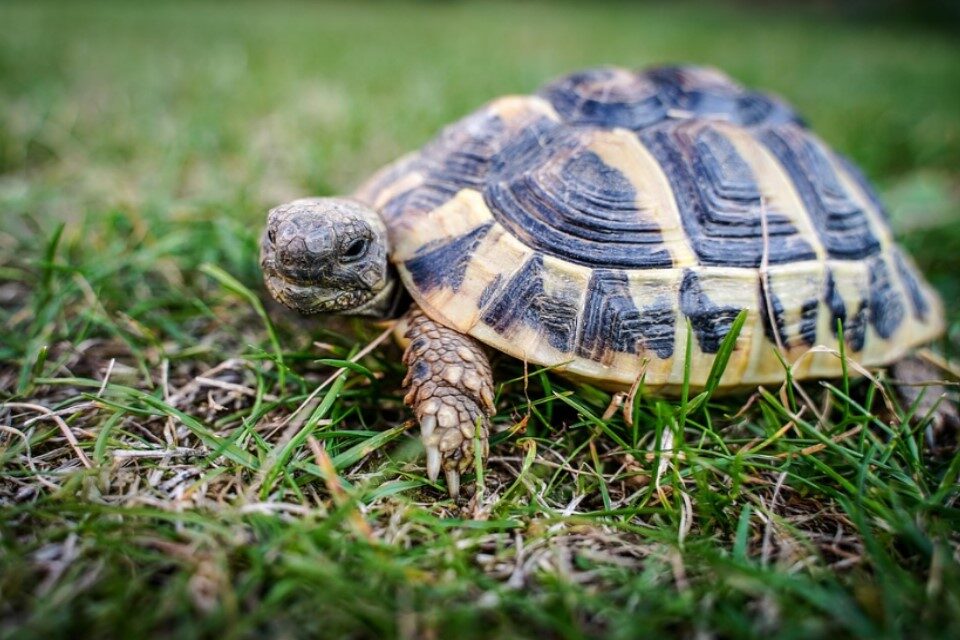Hermann’s turtle is often confused with the Greek turtle, because the shells of these two turtles are very similar. For the uninitiated it can therefore be difficult to distinguish these two species of land turtle as the differences between the Hermann and the Greek turtle are subtle. In addition, depending on the age and size of the animal, these signs are more or less recognizable.
How to differentiate the Hermann tortoise from the Greek tortoise
What you can immediately see,
- Unique scale in a Greek tortoise
- Double scale in a Hermann tortoise
The supracaudal scale appearance is the best way to dissociate a Hermann turtle from a Greek turtle. This scale is located at the back of the carapace, just above the tail. The supracaudal scale of Hermann’s tortoise forms a single block, while that of the Greek tortoise is divided into two parts.
Male and female Greek tortoises have two horny spurs visible just behind the thighs, an element that Hermann’s tortoises do not have.
The Hermann turtle has a horny claw at the end of its tail, but the Greek turtle does not.
Greek turtles have color spots on the shell that are less contrasting than in Hermann’s turtles.
In its natural environment, the Greek tortoise is an animal that lives in North Africa and some countries in the Middle East. The Hermann tortoise lives in France and the Mediterranean regions, as far as northern Turkey. The testudo hermanni is the only species living naturally in the south of France.
The plastron size of the testudo graeca differs greatly depending on the subspecies, age and sex. In adulthood the male testudo graeca is smaller than the female, and has a size of about 15 cm. The largest subspecies of Testudo graeca are females and can grow up to 30 cm in length.
The conservation status (IUCN) of testudo graeca is classified as threatened. Its current status is also indicated as vulnerable (VU A1cd status). This does not mean, however, that testudo graeca is on the verge of extinction.
The status of the Hermann turtle is slightly less worrying. The conservation status of testudo hermanni indicates that this species is almost threatened (NT status).
These two species therefore benefit from advanced protection. The holding and sale of these species are regulated by Annex A of the European Regulation and by Annex II of the Washington Convention.
The differences between testudo hermanni and boettgeri
The Hermann turtle has two subspecies. The western subspecies testudo hermanii hermanii, and the eastern subspecies tesdudo hermanni boettgeri.
The adult female Testudo hermanni boettgeri is the largest subspecies and can grow up to 30 cm in length. There are also some color differences between the hermann hermanni and boettgeri turtle.
The colors of the testudo hermanni hermanni are more vivid, and have a yellow tint and patterns with deep black. On its breastplate and along its shell are two black bands on each side. The plastron of the testudo hermanni hermanni, which corresponds to the underside of the carapace, is light in color with a few scattered black spots.
Testudo hermanni boettgeri have colors that may appear duller compared to its cousin, testudo hermanni hermanni. The black patterns are more blurry and less well defined.
Regardless of the subspecies, the plastron of males is always flat compared to that of females. The tail of males is also longer.
The differences between a Hermann’s tortoise and a Steppe tortoise are much more obvious. Their carapace have a very different appearance and color. The Steppe Turtle’s shell is much flatter, and its scales are more widely spaced.
To differentiate a marginata turtle from a Hermann turtle, you have to observe the edges of the shell. Those of the marginata turtle are curved and edged, which explains its other name, the bordered turtle.
Is it possible to put a Greek tortoise and hermann together
In captivity it is totally inadvisable to put a Hermann turtle and a Greek turtle together in the same enclosure.
Although these turtles look very similar, they are two very different species of reptiles. It is therefore necessary to place them in two separate enclosures in order to prevent them from reproducing between them, and the birth of hybrid species.
It is important that everyone participates in the protection of species by avoiding cohabitation. In nature it is very rare that testudo hermanni and testudo graeca meet, as they are not located in the same regions at all.
Cohabitation is also a danger to the health of your turtles. Because these two species of reptiles can transmit diseases, such as herpes, which has serious consequences in turtles. In particular with regard to the Greek tortoise which is more fragile. The state of health can therefore rub off on that of its congeners.
Reproduction of land turtles
The methods of breeding Greek and Hermann turtles are similar. Egg-laying can occur several times a year, provided both male and female turtles are sexually mature. The mating of these turtle species is stimulated during strong periods of heat. Several weeks after mating, the female digs a hole with her legs.
The number of eggs laid by the female depends on the size and age of the animal. It is generally between 2 to 12 eggs which obtained, during one or more successive layings. The female then carefully fills the hole with her hind legs.
Immediately after laying, these eggs should be placed in an artificial incubator, with a cross in grease pencil in order to prevent them from being turned over.
Incubation in the natural environment is possible, but requires excellent weather. Babies hatch about 8 to 9 weeks after they are laid.
The good health of babies depends on the incubation conditions. Too high a temperature is often the cause of malformation in babies. In case of egg retention, the female should be taken to a competent veterinarian. This veterinarian may have to anesthetize the turtle in order to manually extract its eggs.
